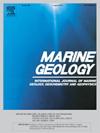Recent mass transport deposits in the Gulf of Cagliari
IF 2.2
3区 地球科学
Q2 GEOSCIENCES, MULTIDISCIPLINARY
引用次数: 0
Abstract
Sedimentary deposits due to slope failures and submarine landslides are common on continental margins. The availability of five new high resolution 2D multi-channel seismic profiles, integrated by Multibeam data, provides unprecedented insight into the shallow submarine geomorphology of the Gulf of Cagliari. The study area, located in the southern Sardinia offshore, exhibits several Mass Transport Deposits (MTDs) during the Upper Quaternary. They move from the continental slope and the north-east flank of the Banghittu High.
We identified the recent 26 km long MTD-CG1, of which we interpreted the translational domain, characterized by weak deformation, and the toe domain, with a predominantly compressional and erosional regime. This erosion is produced locally by the basal shear zone (bsz) which represents the detachment surface of the slide. Both MTD domains are crossed by vertical conduits and fluid migration that produce buried pockmarks. In the translational domain an underlying carbonate buildup offered greater strength to sliding, resulting in an undisturbed sector. The MTD-CG1 is composed of Middle-Upper Pleistocene sediments which, during the Holocene, assumed an initial direction towards SE, to become towards the SW in the Carbonara Valley. After the gliding, the MTD was cut by the last incision phase of the canyon system which markedly characterizes the physiography of the gulf.
The MTD-CG1 is primarily predisposed to instability by its steep slope gradient and fluid presence, while possible triggers include eustatic sea level changes and seismic activity.
卡利亚里湾近期的大块搬运沉积物
由于斜坡破坏和海底滑坡造成的沉积沉积在大陆边缘很常见。五个新的高分辨率二维多通道地震剖面的可用性,结合Multibeam数据,为卡利亚里湾浅层海底地貌提供了前所未有的见解。研究区位于撒丁岛南部近海,在上第四纪表现出若干块体搬运沉积(MTDs)。它们从大陆斜坡和班希图高地的东北侧移动。我们确定了最近26 km长的MTD-CG1,并解释了以弱变形为特征的平移域和以挤压和侵蚀为主的趾部域。这种侵蚀是由代表滑坡剥离面的基底剪切带(bsz)在局部产生的。两个MTD域都被垂直管道和流体运移穿过,产生了埋藏的麻子。在平移区域,下方的碳酸盐堆积为滑动提供了更大的强度,从而形成了一个未受干扰的区域。MTD-CG1由中-上更新世沉积物组成,在全新世期间,这些沉积物在Carbonara Valley的初始方向为东南向,后来转变为西南向。滑动后,MTD被峡谷系统的最后切割阶段切割,这明显表征了海湾的地形特征。MTD-CG1的不稳定性主要是由于其陡峭的坡度和流体的存在,而可能的触发因素包括海平面上升变化和地震活动。
本文章由计算机程序翻译,如有差异,请以英文原文为准。
求助全文
约1分钟内获得全文
求助全文
来源期刊

Marine Geology
地学-地球科学综合
CiteScore
6.10
自引率
6.90%
发文量
175
审稿时长
21.9 weeks
期刊介绍:
Marine Geology is the premier international journal on marine geological processes in the broadest sense. We seek papers that are comprehensive, interdisciplinary and synthetic that will be lasting contributions to the field. Although most papers are based on regional studies, they must demonstrate new findings of international significance. We accept papers on subjects as diverse as seafloor hydrothermal systems, beach dynamics, early diagenesis, microbiological studies in sediments, palaeoclimate studies and geophysical studies of the seabed. We encourage papers that address emerging new fields, for example the influence of anthropogenic processes on coastal/marine geology and coastal/marine geoarchaeology. We insist that the papers are concerned with the marine realm and that they deal with geology: with rocks, sediments, and physical and chemical processes affecting them. Papers should address scientific hypotheses: highly descriptive data compilations or papers that deal only with marine management and risk assessment should be submitted to other journals. Papers on laboratory or modelling studies must demonstrate direct relevance to marine processes or deposits. The primary criteria for acceptance of papers is that the science is of high quality, novel, significant, and of broad international interest.
 求助内容:
求助内容: 应助结果提醒方式:
应助结果提醒方式:


